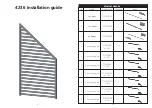
7
Diagnostics and Troubleshooting
Troubleshooting
Thermo Scientific
TSQ Quantum XLS Series User Guide
129
Issue:
Poor high mass
response.
Possible causes/solutions
• Poor high
m/z
ion intensity because the ion source temperature is too high. Reduce the
ion source temperature to reduce the amount of thermal decomposition and
fragmentation of your analyte.
• Poor high
m/z
ion intensity because of bad ion source lens settings. Run the tune and
calibration procedure. See
• Helium pressure in the ion source is too high or low. Set flow to 1.0 mL/min for most
applications.
• There is a vacuum leak. Find and repair any leaks. Be sure to check the transfer line fitting
in the GC oven. See
for more information.
• An excess amount of low
m/z
ions, such as hydrocarbons or column bleed. Remedy the
source of these low
m/z
ions.
• The ion volume or lenses are contaminated. Clean the ion volume or lenses. See
“Cleaning Ion Source Components”
•
m/z
131 is not base peak because the multiplier gain is too low. The multiplier gain
calibration may set the multiplier voltage too low for a noisy multiplier. Electron
multipliers older than 2 to 3 years are often noisy. Contact Thermo Fisher Scientific
Technical Support.
• There is poor high
m/z
intensity and poor resolution of low
m/z
ions because the
conversion dynode is faulty. Contact Thermo Fisher Scientific Technical Support.
• The injection rf is not calibrated. Run the tune and calibration procedure as described in
• There is a problem with the filament or lens control. See
for more information.
• Reagent gas is leaking into the analyzer and suppressing the EI signal. Check for the
presence of CI reagent ions in the spectrum. Replace the CI Reagent Gas Flow Module if
necessary.
















































